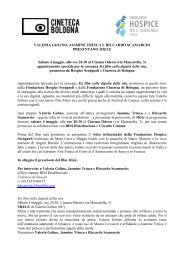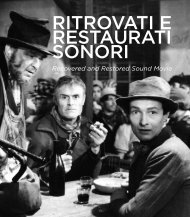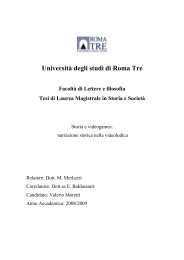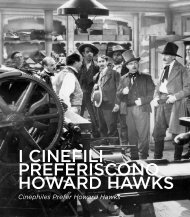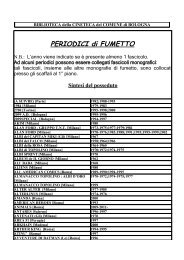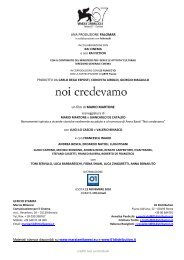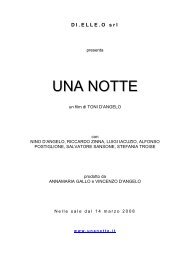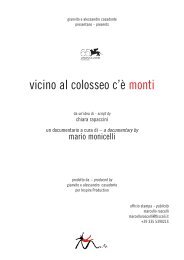You also want an ePaper? Increase the reach of your titles
YUMPU automatically turns print PDFs into web optimized ePapers that Google loves.
Fuori dalla fumeria. Ma se lo spettatore del Cinema Ritrovato volesse<br />
non perdersi nella fumeria d’oppio <strong>di</strong> Noodles, consigliamo<br />
un bel bagno <strong>di</strong> verità nella sezione Cinema documentario invisibile<br />
che è il frutto del lavoro <strong>di</strong> molti anni. Tutte le cineteche<br />
traboccano <strong>di</strong> documentari, spesso tra molto materiale poco interessante,<br />
si trovano film che aprono la mente e il cuore. È il caso<br />
<strong>di</strong> Black Roots, un potente film <strong>di</strong> Lionel Rogosin, cineasta alla<br />
cui opera da anni de<strong>di</strong>chiamo stu<strong>di</strong>o e restauro; è il caso dei film<br />
dell’italo-francese Mario Ruspoli (nobile <strong>di</strong> nascita come De Sica,<br />
un occhio perduto come Walsh), autore tra il ’56 e il ’72 <strong>di</strong> un<br />
pugno <strong>di</strong> opere che osservano, con genio, gli sconfitti della terra.<br />
Del cinema documentario italiano poco si conosce. Al Cinema<br />
Ritrovato <strong>di</strong> alcuni anni fa presentammo i <strong>di</strong>eci cortometraggi<br />
restaurati <strong>di</strong> Vittorio De Seta, che suscitarono un forte interesse.<br />
Quest’anno abbiamo allestito sette programmi de<strong>di</strong>cati a sette<br />
autori straor<strong>di</strong>nari: Andreassi, Bal<strong>di</strong>, Casa<strong>di</strong>o, Di Gianni, Mangini,<br />
Piccon, Vancini. I loro documentari ci restituiscono con forza,<br />
intelligenza e coraggio l’Italia che stava cambiando tra gli anni<br />
Cinquanta e i primi Settanta. Vederli oggi sarà come ritrovare le<br />
ra<strong>di</strong>ci <strong>di</strong> un Paese che ha smarrito oggi la sua identità. Completano<br />
il programma alcuni home movies che ci fanno scoprire il<br />
<strong>di</strong>etro le quinte della finzione, quella del set (i filmati <strong>di</strong> Marcello<br />
Marchesi e <strong>di</strong> Alessandro Blasetti), ma anche quella della propaganda,<br />
il formidabile Da <strong>Bologna</strong> a Stalino. A proposito <strong>di</strong> verità:<br />
la mostra La comunità del cinema de<strong>di</strong>cata al ‘poeta del reportage’<br />
Mario Dondero ci restituisce, attraverso le immagini fisse, la<br />
profon<strong>di</strong>tà e il mistero degli artisti che ha fotografato.<br />
Digitale. Il Cinema Ritrovato è nato nella sala della <strong>Cineteca</strong> <strong>di</strong><br />
via Pietralata, 170 posti. Negli anni il pubblico è cresciuto, ci<br />
siamo trasferiti al cinema Fulgor, nel cortile <strong>di</strong> Palazzo d’Accursio,<br />
in Piazza Maggiore, e oggi dalle nove del mattino fino a sera<br />
occupiamo quattro sale, i due Lumière, il Jolly e l’Arlecchino.<br />
L’anno passato il festival è stato frequentato da oltre sessantaseimila<br />
spettatori. Certo Il Cinema Ritrovato è il festival delle<br />
cineteche, luogo d’incontro <strong>di</strong> archivisti e stu<strong>di</strong>osi, ma da alcuni<br />
anni registriamo la presenza d’una crescente popolazione <strong>di</strong><br />
giovani. In Italia da quarant’anni si <strong>di</strong>ce che il cinema è morto.<br />
Non solo questo non era vero in passato e non lo è oggi, ma,<br />
forse, sta nascendo una nuova cinefilia che ha lasciato alle spalle<br />
semiologia e ideologia, che consuma film dalla rete ma frequenta<br />
anche la sala, e che ha voglia <strong>di</strong> confrontarsi con il cinema del<br />
passato. Che cosa attira questo pubblico al Cinema Ritrovato?<br />
Cre<strong>di</strong>amo soprattutto un rinnovato desiderio <strong>di</strong> conoscenza della<br />
storia. Basta sfogliare questo catalogo per rendersi conto <strong>di</strong><br />
quanto il festival consenta <strong>di</strong> confrontarsi, attraverso documenti<br />
eccezionali, con i fatti e le idee che costituiscono il Novecento.<br />
Mai come oggi siamo circondati da immagini, sempre più uguali<br />
tra loro. Il Cinema Ritrovato, gli archivi, sono miniere inesauribili<br />
<strong>di</strong> immagini identitarie e <strong>di</strong>fferenti, che un nuovo pubblico può<br />
conoscere e utilizzare.<br />
A <strong>Bologna</strong> si terrà l’annuale seminario <strong>di</strong> Europa Cinemas, il progetto<br />
che riunisce oltre mille cinema d’essai in Europa. Le sale<br />
sono in mezzo al guado, come alla fine degli anni Venti del secolo<br />
scorso. Oggi non è il passaggio dal muto al sonoro, ma dalla<br />
pellicola al <strong>di</strong>gitale. La rottamazione è partita e tra pochi anni<br />
sarà molto <strong>di</strong>fficile proiettare le copie in pellicola: le sale, per<br />
14<br />
Outside the den. If Il Cinema Ritrovato viewers do not want to get<br />
lost in Noodles’ opium den, we suggest a cold shower of reality<br />
with Invisible Documentaries. All film archives are brimming with<br />
documentaries, and often among reels of little interest there are<br />
works that open the mind and heart. That is the case of Black<br />
Roots, a powerful film by Lionel Rogosin, to whom we have de<strong>di</strong>cated<br />
years of study and restoration. The same can be said of<br />
Franco-Italian Mario Ruspoli (noble by birth like De Sica, one eye<br />
short like Walsh), the <strong>di</strong>rector of a handful of films between ‘56<br />
and ‘72 that brilliantly observe the underdogs of the world.<br />
Little is known about Italian documentary film. Several years ago<br />
we presented ten restored shorts by Vittorio de Seta that generated<br />
great interest. This year we have put together seven programs<br />
de<strong>di</strong>cated to seven extraor<strong>di</strong>nary filmmakers: Andreassi, Bal<strong>di</strong>,<br />
Casa<strong>di</strong>o, Di Gianni, Mangini, Piccon, and Vancini, all of whom<br />
bravely captured how Italy was changing between the 1950s and<br />
early ‘70s. Seeing them now will be like re<strong>di</strong>scovering the roots<br />
of a country that today has lost its identity. To top things off, our<br />
program will include a few home movies that give us a behind<br />
the scenes view of fictional films, on the set (footage by Marcello<br />
Marchesi and Alessandro Blasetti), but also of propaganda films,<br />
like the formidable Da <strong>Bologna</strong> a Stalino. Speaking of reality, the<br />
exhibition The Film Community de<strong>di</strong>cated to the “poet of reportage”<br />
Mario Dondero gives us a chance to experience the depth<br />
and mystery of the artists he photographed.<br />
Digital. Il Cinema Ritrovato began at the <strong>Cineteca</strong>’s theater<br />
on Via Pietralata with 170 seats. Over the years our au<strong>di</strong>ence<br />
grew, and we moved to the Fulgor theater, in the courtyard of<br />
Palazzo d’Accursio, in Piazza Maggiore. Today from morning to<br />
evening, we occupy four theaters, two at Lumière, the Jolly, and<br />
the Arlecchino. Last year the festival had a headcount of over<br />
sixty-six thousand spectators. Naturally, Il Cinema Ritrovato is a<br />
festival of film archives, a meeting place for archivists and scholars,<br />
but for several years we have noticed a growing number of<br />
young people. For forty years now people have been saying that<br />
film is dead in Italy. Not only was this not true in the past, but it<br />
also is not today. Perhaps a new generation of cinephiles is in the<br />
making today, one that has left behind semiotics and ideology,<br />
that watches films online but in theaters too, and that wants to<br />
investigate cinema from the past. What draws this au<strong>di</strong>ence to Il<br />
Cinema Ritrovato? We believe the inspiration is a renewed interest<br />
in learning history. Flip through the pages of this catalog to<br />
see just how much this festival allows spectators to explore the<br />
facts and ideas of the 1900s through exceptional documents. We<br />
have never been so surrounded by images as we are today – images<br />
that are increasingly in<strong>di</strong>stinct from one another. Il Cinema<br />
Ritrovato and archives are an endless source of <strong>di</strong>verse and specific<br />
images, which a new au<strong>di</strong>ence may <strong>di</strong>scover and use.<br />
The annual Europe Cinemas seminar will be held in <strong>Bologna</strong>, a<br />
project that unites over a thousand European art house cinemas.<br />
Theaters are in the midst of a transition, like at the end of the<br />
1920s. Today it is not about the change from silent to sound but<br />
from film stock to <strong>di</strong>gital. Demolition is already underway, and<br />
just a few years from now it will be hard to screen film stock:<br />
to accommodate <strong>di</strong>gital technology, cinemas are already <strong>di</strong>smantling<br />
tra<strong>di</strong>tional projectors. It is the end of an era. Film stock will



